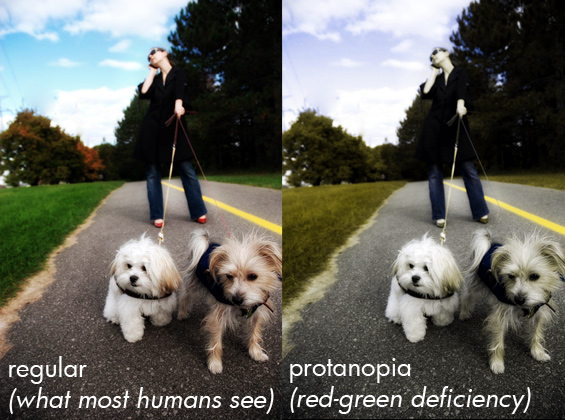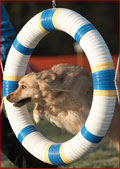What colours can dogs see?
From:OttawaDogBlog.ca
It was long speculated that dogs were completely colour blind, seeing the world in black and white. In recent years, studies have confirmed that dogs, although not able to see the full colour spectrum as humans, can see limited colour because they have a red-green colour deficiency known as Protanopia. 1% of human males also have this phenomenon. With Protanopia, the eye lacks the long-wavelength sensitive retinal cones making it impossible to differentiate between the green-yellow-red section of the colour spectrum.

For the protanope, the brightness of red, orange, and yellow is much reduced compared to normal. This dimming can be so pronounced that reds may be confused with black or dark gray, and red traffic lights may appear to be extinguished. They may learn to distinguish reds from yellows and from greens primarily on the basis of their apparent brightness or lightness, not on any perceptible hue difference. – from Wikipedia

Humans are trichromatic, meaning that we can see three primary colours; red, green and blue. We are taught this in primary school, mixing those three colours to form the rest. Dogs, on the other hand, are dichromatic, meaning they can see two primary colours; blue and yellow (hence the red-green deficiency).
Humans have 7 times higher proportion of cone cells than dogs, meaning that when dogs do see colors, they are pale or faded. However dogs have a much higher concentration of rod cells, responsible for seeing black-and-white, and also much more sensitive in lower light conditions. For that reason, dogs have much better night vision than people. – from WikiAnswers
 We do have to remember that although dogs may have a colour deficiency in their vision, their sense of smell is far better than humans! Dogs can also detect movement far better than us and they have a much bigger range of field of view.
We do have to remember that although dogs may have a colour deficiency in their vision, their sense of smell is far better than humans! Dogs can also detect movement far better than us and they have a much bigger range of field of view.

 can dogs see colour,
can dogs see colour,  dog colours,
dog colours,  dog's vision,
dog's vision,  dogs eyes in
dogs eyes in  Other
Other 





Reader Comments